|
|
|
|
ASIAN ART
|
|
|
|
|
Click on images for more views
|
|
|
|
|
|
|
|
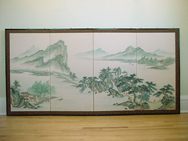
Click on image for more views
|
|
Early 20th C. Chinese Painted Landscape Folding Screen
Date: early 20th C (probably 2nd quarter).
Size: 3' x 6' with four folding panels
Materials: painted on silk fabric; lacquered wood, paper, brass.
Subject: landscape
The predominant color in this landscape is an ethereal jade blue-green painted on a natural cream-colored silk, giving the piece a lovely iridescent inner glow. The small vignettes throughout the landscape—a house with willow tree at the foot of the mountain; the sage crossing a bridge to contemplate a waterfall; the temple overlooking the still lake; the man on horseback embarking on a journey into the unkown; the humble abode across the lake; the other-worldly mountains reaching for the heavens; the knarled eternal pines rooted in the earth—all have their own symbolism while being unified within the whole peacefully balanced composition. Painting is mounted in a rich burgandy brown and gold satin silk brocade and framed in black lacquered wood. Four corners are mounted with decorative incised brass fittings to protect and stabilize the corners. There are brass knobs along the top and bottom edge. The lacquer frame is a bit scuffed in a few spots, but otherwise looks good. There is a bit of wood exposed at the end of one of the frames on the back. There are several faint paint splashes on the water of the right panel. They appear to have been done by the inspired artist who momentarily lost his or her concentration, as it looks like the same ink color as the painting. Perhaps this could be removed with proper restoration, though it's not too distracting from the beauty and peacefulness of the landscape. Overall, the piece is in very good condition and has a lovely old patina as all the natural materials have mellowed well with age. There are metal loops on the back to hang the screen on the wall. There are two tiny gold oval labels, one in each upper corner marked 'Made in Hong Kong". Although it is an unsigned 'production' piece, likely made for export, it is none-the-less a lovely work of art that would greatly enhance any room.
|
|
Item #aa07
$1,400
|
|
|
|
|
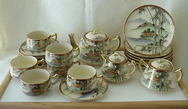
Click on image for more views
|
|
Mid 20th Century Japanese Satsuma Tea Set
Date: 2nd quarter 20th C.
This is a complete set in mint condition—a rare find. Set includes teapot with lid, creamer with lid, sugar with lid, six cups & saucers, six 6 1/2" desert plates. Came out of an estate of a man who purchased the set in Japan during the Korean war and said it sat unused in the china cabinet the whole time—hence the excellent condition. Each piece is marked in gold: Soko china / Hand-Painted / MADE IN JAPAN with two Japanese characters in vertical rectangle (see picture). The color palette is so lovely—celedon green bamboo, cherry blossom pink, sky water blue, peach with touches of orange and red with gold outlines in a cream-colored crackled glaze, typical of satsuma ware. Each piece is completely hand-painted and unique. The rim is painted in the classic rust-red and gold linear triangles pattern. |
|
Item #aa08
$495
|
|
|
|
|
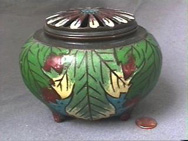
Click on image for more views
|
|
Meiji Period Japanese Bronze Champlevé Censer
This Japanese bronze censer has a unique design. The overall form is triangular with tripod feet which gracefully hold the censer up off the surface on which it rests, giving this heavy piece a sense of weightlessness. The design on the body of the censer is created in the champlevé technique. This technique is similar to cloisonné in that colored emamel is filled in between chanels of metal forming the design. The difference is that with cloisonné, wire is soldered to the surface of the vessel according to the design and then filled in with enamel. With the champlevé technique, the bronze chanels of the design that holds the enamel is cast as an integral part of the vessel. The design on the body of this piece is six downward pointing maple leaves, three of which the leaf point curves out and extends to create the tripod feet. The blue color between the leaves gives the impression of leaves against the blue sky. The removeable lid is designed as a sixteen-petal lotus blossom with open slits between the petals for the incense smoke to escape in a soft misty cloud due to the fine slits arranged in such a manner. There is a chop mark on the bottom which I had translated. It identifies the piece as made in the city of Kyoto. Dimensions are about 10 cm. (about 4") high and about 40 cm. (15 3/4") in diameter at the triagular points. Condition is very good. One petal on the lid had some of the enamel missing and one really has to look hard to see it. On the tips of the feet, the enamel is a bit worn from use. On the main body, the enamel is completely intact with only a few minor spots where the surface is a bit uneven or slightly chipped.
|
|
Item #aa03
$945
|
|
|
|
|
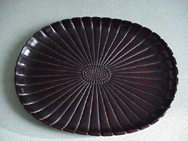
Click on image for more views
|
|
19th Century Meiji Period Japanese Hand-Carved Wood Tray
This is a rare and beautiful piece, made by a master craftsmen. It is hand-carved from a very rare hard wood identified as purple zitan, which was reserved for only the finest craftsmen. It is carved in a lotus pod design from one piece of wood. Dimensions are 14 inches long by 10 3/4 inches wide by about 1 inch deep and about 1/4 to 3/8 inches thick. There is a finely carved artist signiture on the back. Judging from the skillful craftsmanship, the piece was likely made by a well-known 19th C. Japanese wood-carver. Condition is excellent. The piece has a very lovely patina, especially around the rim where the piece has been handled. On the back, there are a few minor wear spots from use and what appears to be a small water drop mark where the stain is slightly lighter and the wood grain can be seen more clearly. The wood finish is a dark deep reddish brown color, giving the piece a very rich appearance.
|
|
Item #aa05
$1,450
|
|
|
|
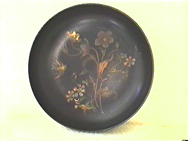
Click on image for more views
|
|
Early 19th Century Japanese Painted Lacquerware Bowl
This is an unusual piece—dark and elegant. The painted design is a bouquet of poppy flowers and a flying swallow. It is in muted tones of rusty orange, gold and green. It appears that the design was at one time covered with gold leaf, and is now worn to only a few spots. On the underside of the bowl, there is an unusual repeated pattern of what appears to be Liberty Bells which seem to have transfered to the bowl from an image from packing material or something. It is a real mystery yet to be solved. Dimensions of the piece are 11 1/4" diameter by 2 1/4" deep. Condition is very good considering it's age. It has a patina which shows it's natural wear from use which gives it an authentic feel. There is one small area inside the bowl where the lacquer is worn down to the base. The light-colored spots on the bottom are residual material on the surface, perhaps paint, which could likely be carefully removed. The bowl is very light weight.
|
|
Item #aa06
$850
|
|
|
|
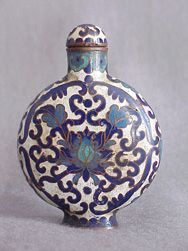
Click on image for more views
|
|
18th Century Ch'ing Dynasty Chinese Cloisonné Snuff Bottle
Date: 1736-1795 Qianlong (Ch'ien Lung)—Ch'ing Dynasty
Materials: cloisonné enamel on copper base
Size: 2 13/16" tall x 2" wide x 3/4" deep
Condition: Excellent condition. Shows natural patina from use especially on
lid and sides of bottle. White shows some darkening from use, probably from oil on skin.
Maker's Mark: There is a mark on the underside of the foot. According to my resources, it matches the mark for the Qianlong (Ch'ien Lung) from 1736 to1795 during the Ch'ing Dynasty.
Description: This is a lovely snuff bottle in the classic 'moon flask' form of the Qianlong period. Made with at least 3 shades of blue enamel on a white background. Copper wire used for the cloisonné outline. Design consists of floral tendrils surrounding what appears to be a traditional crysanthimum blossom, one on each side of the bottle. Shape of bottle is a rounded pill-like form. The lid has a cabochon shape and attached to it is a slender copper spoon which reaches nearly to the bottom of the bottle. This spoon is used to lift out the snuff from the bottle. Fits into the hand very nicely, and feels like a smoothly worn pebble.
|
|
Item #aa04
$450
|
|
|
|

Click on image for more views
|
|
19th Century Chinese Wooden Wedding Bowl Rack
Date: Mid-late 19th Century
Size: 22 inches high; bowls 7 1/2 inches diameter
Materials: Hand carved and painted wood with iron handle
Imagery: Bird sitting on tree branch, auspicious Chinese symbols. Each bowl design is varied as to the position of bird and branch, and the arrangement and selection of the 4 surrounding symbols. There are 5 auspiscious sybols used: the gourd, sword, flute, lotus bud, and perhaps firecracker.
Markings: 2 bowls unmarked, 4 bowls marked with same 4 characters; 6 bowls marked with 4 different characters
Description: The wooden four-footed rack is an ingenious design. The top of one of the legs is hinged with a metal pin to open for removal of bowls. The top and bottom structure is in the auspicious form of the whirling log or pinwheel configuration. The top is mounted with an iron handle so the whole rack loaded with the stack of 12 bowls, another auspicious number, can be easily carried. The bowls are carved with a deep foot and convex interior which nest together perfectly, making for a very stable column of bowls when stacked. Each bowl is banded on the exterior with a double-twisted metal wire in order to stablize the wood and keep it from cracking. This is obviously an indigenous piece made for use within the culture rather than a tourist piece made for export. It is not a production piece—each bowl, although containing the same basic elements, is unique. Each bird and branch position is different, and each bowl has a different configuration of the four surrounding symbols, leading me to belive that these bowls may have been used as offering bowls within a wedding ceremony.
Condition: The piece is in excellent condition. It has a wonderful old patina. It is made with no nails—an excellent example of indigenous Chinese folkart. The wooden pieces are held together with a tongue and groove construction.
|
|
Item #aa09
$450
|
|
|
|
|
|
|
|
|
|
|
|
|